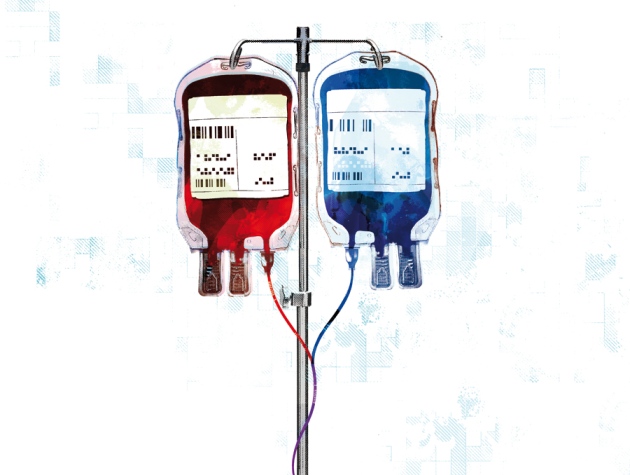Dr. Weeks’ Comment: “Young blood”, no longer a metaphor. The upside is astronomical… and so is the abuse potential.
Ageing research: Blood to blood
By splicing animals together, scientists have shown that young blood rejuvenates old tissues. Now, they are testing whether it works for humans.

Illustration by Gary Neill
Two mice perch side by side, nibbling a food pellet. As one turns to the left, it becomes clear that food is not all that they share ”” their front and back legs have been cinched together, and a neat row of sutures runs the length of their bodies, connecting their skin. Under the skin, however, the animals are joined in another, more profound way: they are pumping each other’s blood.

Parabiosis is a 150-year-old surgical technique that unites the vasculature of two living animals. (The word comes from the Greek para, meaning ‘alongside’, and bios, meaning ‘life’.) It mimics natural instances of shared blood supply, such as in conjoined twins or animals that share a placenta in the womb.
In the lab, parabiosis presents a rare opportunity to test what circulating factors in the blood of one animal do when they enter another animal. Experiments with parabiotic rodent pairs have led to breakthroughs in endocrinology, tumour biology and immunology, but most of those discoveries occurred more than 35 years ago. For reasons that are not entirely clear, the technique fell out of favour after the 1970s.
In the past few years, however, a small number of labs have revived parabiosis, especially in the field of ageing research. By joining the circulatory system of an old mouse to that of a young mouse, scientists have produced some remarkable results. In the heart, brain, muscles and almost every other tissue examined, the blood of young mice seems to bring new life to ageing organs, making old mice stronger, smarter and healthier. It even makes their fur shinier. Now these labs have begun to identify the components of young blood that are responsible for these changes. And last September, a clinical trial in California became the first to start testing the benefits of young blood in older people with Alzheimer’s disease.
“I think it is rejuvenation,” says Tony Wyss-Coray, a neurologist at Stanford University in California who founded a company that is running the trial. “We are restarting the ageing clock.”
Many of his colleagues are more cautious about making such claims. “We’re not de-ageing animals,” says Amy Wagers, a stem-cell researcher at Harvard University in Cambridge, Massachusetts, who has identified a muscle-rejuvenating factor in young mouse blood. Wagers argues that such factors are not turning old tissues into young ones, but are instead helping them to repair damage. “We’re restoring function to tissues.”
She emphasizes that no one has convincingly shown that young blood lengthens lives, and there is no promise that it will. Still, she says that young blood, or factors from it, may hold promise for helping elderly people to heal after surgery, or treating diseases of ageing.
“It’s very provocative,” says Mark Mattson, chief of the Laboratory of Neurosciences at the US National Institute on Aging in Bethesda, Maryland, who has not been involved in the parabiosis work. “It makes you think. Maybe I should bank some blood of my daughter’s son, so if I start to have any cognitive problems, I’ll have some help,” he says, only half-joking.
….For the rest of the story CLICK HERE

